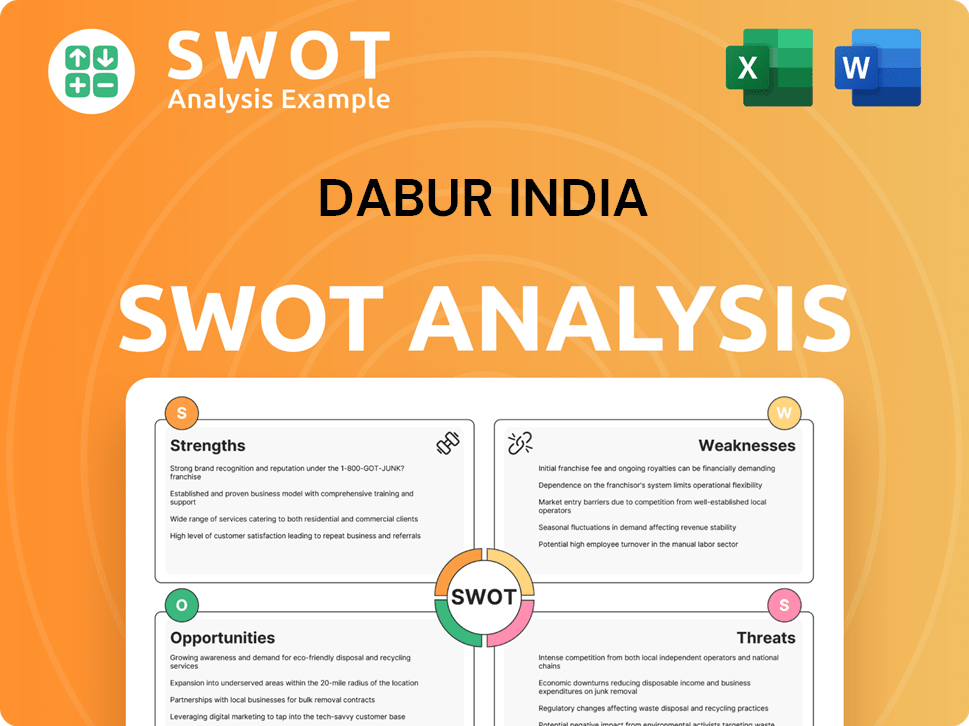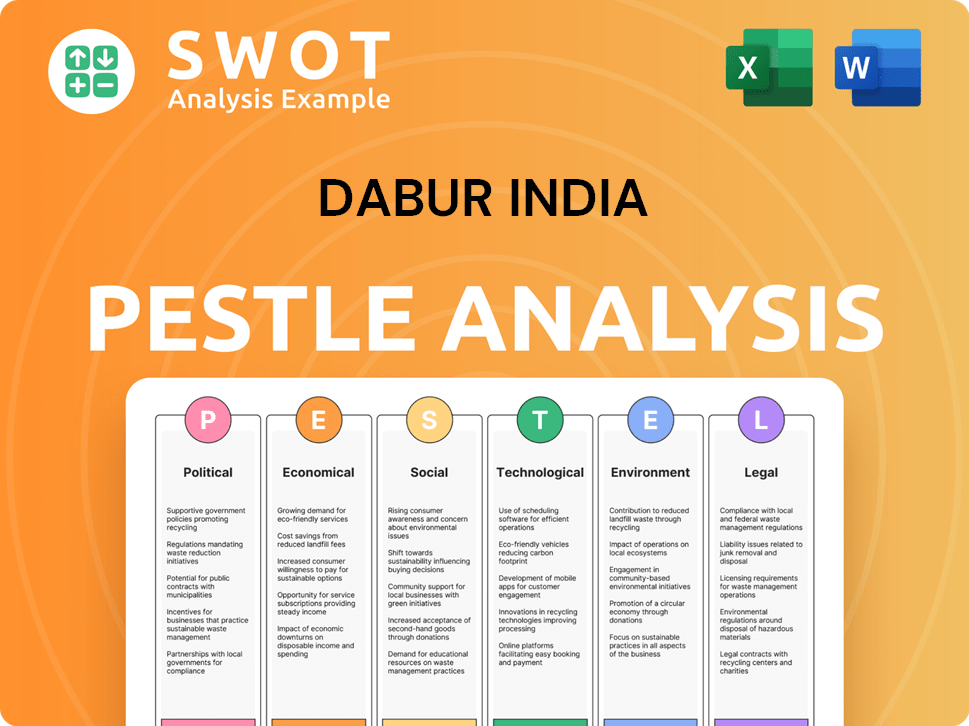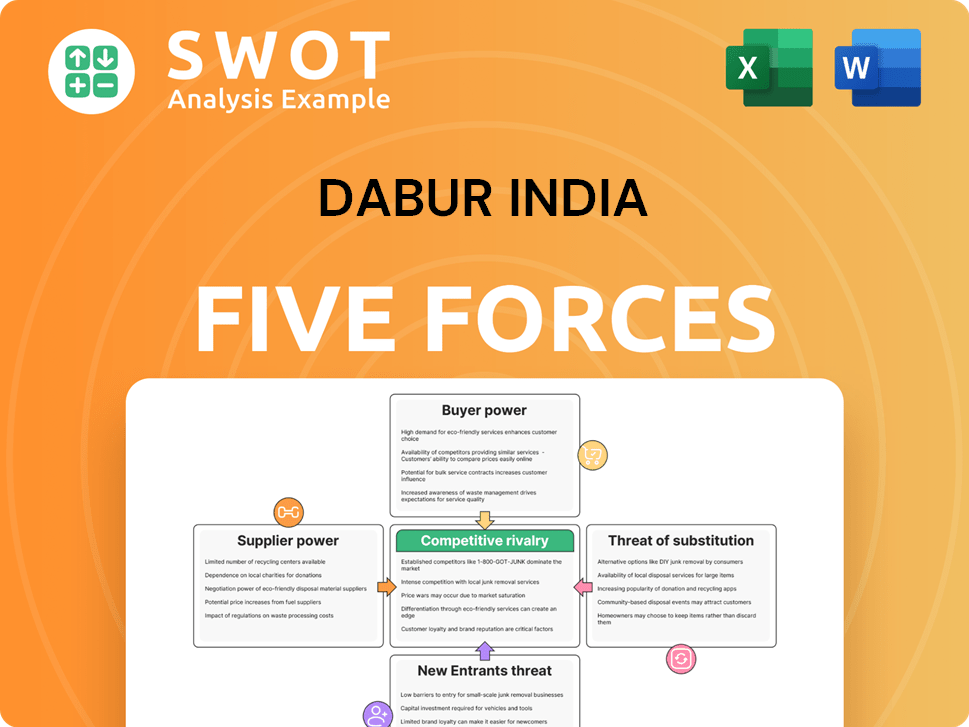Dabur India Bundle
How Did Dabur India Rise to Become a FMCG Giant?
Delve into the fascinating Dabur India SWOT Analysis and discover the remarkable story of Dabur India Limited, a company that began with a vision to make Ayurvedic medicine accessible to all. From its inception in 1884 in Calcutta, founded by Dr. S.K. Burman, Dabur embarked on a journey to blend ancient Ayurvedic wisdom with modern practices. This pioneering spirit would eventually transform into one of India's most respected consumer goods companies.

Understanding the brief history of Dabur India means exploring the evolution of an Indian FMCG powerhouse. Dabur's early years were marked by a commitment to Ayurvedic products, which laid the foundation for its future growth. Today, Dabur's brands are a household name, reflecting its enduring legacy and significant impact on the Indian economy. This article will explore Dabur India's journey, from its humble beginnings to its current status as a global leader.
What is the Dabur India Founding Story?
The story of Dabur India begins in 1884, marking the inception of one of India's leading consumer goods companies. Dr. S.K. Burman established the company in Calcutta, driven by a vision to standardize and improve the quality of Ayurvedic medicines. This founding marked the beginning of a journey that would transform the landscape of the Indian FMCG sector.
Dr. Burman, an Ayurvedic practitioner, saw a crucial need for reliable and effective Ayurvedic remedies. His medical background heavily influenced his entrepreneurial spirit. He aimed to provide dependable treatments for widespread diseases like cholera and malaria. This commitment to quality and efficacy became a core principle of the company.
The company's early business model centered on formulating and distributing Ayurvedic medicines. Key products included 'Dabur Churna,' a digestive aid, and 'Dabur Taila,' a hair oil. The name 'Dabur' is a combination of 'Da' for Daktar (doctor) and 'Bur' for Burman, reflecting the founder's identity and medical background. The initial funding came from Dr. Burman's personal resources and medical practice. The late 19th-century Indian context, with its increasing health awareness and reliance on traditional medicine, provided a favorable environment for Dabur's establishment. Dr. Burman's emphasis on scientific rigor in Ayurvedic formulations distinguished Dabur, setting the stage for its future success.
Dabur India Limited was founded on December 2, 1884, by Dr. S.K. Burman in Calcutta, marking the beginning of a journey in the Indian FMCG sector.
- Dr. Burman, an Ayurvedic practitioner, identified the need for standardized Ayurvedic medicines.
- The original business model focused on formulating and dispensing Ayurvedic medicines.
- Dabur's name, a portmanteau of 'Da' for Daktar and 'Bur' for Burman, reflects its roots.
- Initial funding was through bootstrapping, leveraging Dr. Burman's personal resources.
Dabur India SWOT Analysis
- Complete SWOT Breakdown
- Fully Customizable
- Editable in Excel & Word
- Professional Formatting
- Investor-Ready Format

What Drove the Early Growth of Dabur India?
The early growth of Dabur India was marked by strategic expansion and product diversification. The company broadened its Ayurvedic product range and extended its distribution network. This period was crucial for establishing a strong foundation in the Indian market. A deep dive into the Target Market of Dabur India reveals how these early strategies shaped its consumer base.
In the early 20th century, Dabur introduced several new Ayurvedic formulations. A notable product was Chyawanprash, which quickly gained popularity. This expansion of the product portfolio helped to meet the growing demand for Ayurvedic products.
To meet increasing demand, Dabur established manufacturing facilities. The company expanded its reach beyond Calcutta, establishing a presence in other major Indian cities. This expansion was facilitated by a growing network of distributors.
A significant milestone was the formal incorporation of Dabur (Dr. S.K. Burman) Pvt. Ltd. in 1936. Post-independence, Dabur experienced accelerated growth due to a burgeoning Indian consumer market. This period also saw diversification into new categories, such as personal care.
The strategic decision to leverage its Ayurvedic heritage while embracing modern marketing was crucial. By the late 20th century, Dabur transformed from a regional Ayurvedic firm into a national consumer goods company. This transformation set the stage for future global ambitions.
Dabur India PESTLE Analysis
- Covers All 6 PESTLE Categories
- No Research Needed – Save Hours of Work
- Built by Experts, Trusted by Consultants
- Instant Download, Ready to Use
- 100% Editable, Fully Customizable

What are the key Milestones in Dabur India history?
The Dabur India company's journey is marked by significant milestones that have shaped its growth and market position. From its humble beginnings to its current status as a leading player in the Indian FMCG sector, Dabur's history is a testament to its adaptability and strategic vision. Understanding Dabur India's journey provides valuable insights into its evolution and impact on the Indian economy.
| Year | Milestone |
|---|---|
| 1884 | Dabur was founded by Dr. S. K. Burman in Kolkata, marking the beginning of its journey in the Ayurvedic products market. |
| Early 1900s | Introduction of standardized, branded Ayurvedic products, a pioneering move in the industry. |
| 1936 | The company established its first manufacturing unit. |
| 1979 | Dabur entered the oral care market with Dabur Red Toothpaste. |
| 1990s | Aggressive diversification into various categories, including digestives and hair care, expanded the Dabur brands portfolio. |
| 1998 | Separation of family ownership from daily management, bringing in professional CEOs. |
| 2000s | Focused expansion into international markets and increased investment in research and development. |
| 2024 | E-commerce sales contribute approximately 7.5% to its India FMCG business as of Q3 FY24, showcasing its adaptation to digital commerce trends. |
Dabur India has consistently embraced innovation to stay ahead in the competitive market. A key innovation was the introduction of standardized and branded Ayurvedic products, which built consumer trust and set a new standard. The company has also secured numerous patents for its formulations and manufacturing processes, demonstrating its commitment to scientific research within Ayurveda, and continues to innovate in product development and marketing strategies.
The introduction of standardized, branded Ayurvedic products was a groundbreaking move, ensuring consistent quality and efficacy.
Aggressive diversification into categories like oral care and digestives expanded the product portfolio and catered to evolving consumer needs.
Securing numerous patents for formulations and processes reinforced the commitment to scientific research within Ayurveda.
Focus on fortifying its e-commerce presence, with e-commerce sales contributing significantly to its India FMCG business.
Collaborations and strategic partnerships to expand market reach and enhance product offerings.
Incorporating sustainable practices in manufacturing and sourcing to align with environmental concerns.
Dabur India has faced several challenges, including intense competition from both domestic and multinational players. Economic liberalization in the 1990s opened the Indian market, increasing competition. To navigate these challenges, Dabur has focused on strategic restructuring and adapting to market dynamics. For a deeper understanding of the competitive landscape, explore the Dabur's competitors.
Competition from both domestic and multinational FMCG players has been a constant challenge.
Economic liberalization in the 1990s opened the Indian market, increasing competition.
Evolving regulatory landscapes have required continuous adaptation and compliance.
Navigating market downturns and commodity price fluctuations required supply chain efficiencies and cost optimization.
Adapting to evolving consumer needs and preferences, including health and wellness trends.
Managing supply chain disruptions and ensuring product availability during unforeseen events.
Dabur India Business Model Canvas
- Complete 9-Block Business Model Canvas
- Effortlessly Communicate Your Business Strategy
- Investor-Ready BMC Format
- 100% Editable and Customizable
- Clear and Structured Layout

What is the Timeline of Key Events for Dabur India?
The story of Dabur India, a prominent player in the Indian FMCG sector, began in 1884 with Dr. S.K. Burman's establishment in Calcutta, focusing on Ayurvedic medicines. This marked the origin of a company that would become synonymous with natural health solutions. Over the years, Dabur India's journey has been marked by strategic expansions, product innovations, and a commitment to its core values, evolving from its humble beginnings to a global presence while staying true to its Ayurvedic heritage. This brief Dabur history showcases how the company has adapted and thrived.
| Year | Key Event |
|---|---|
| 1884 | Dr. S.K. Burman establishes Dabur in Calcutta, initially focusing on Ayurvedic medicines. |
| 1919 | The first R&D unit is established to standardize Ayurvedic formulations, enhancing product quality. |
| 1936 | Dabur (Dr. S.K. Burman) Pvt. Ltd. is officially incorporated, formalizing the business structure. |
| 1940s | Introduction of flagship brands like Dabur Chyawanprash and Dabur Amla Hair Oil, which become household names. |
| 1972 | Manufacturing facilities are relocated to Sahibabad, Uttar Pradesh, supporting significant expansion. |
| 1980s | Diversification into new categories, including oral care with products like Dabur Red Paste. |
| 1994 | Dabur India Limited goes public with its Initial Public Offering (IPO), marking a significant milestone. |
| 1998 | Professionalization of management, separating ownership from daily operations for better efficiency. |
| 2000s | Aggressive international expansion and entry into the food business with brands like Real Juices. |
| 2010s | Focus on health and wellness, natural products, and strengthening rural distribution networks. |
| 2023-2024 | Continued focus on digital transformation, sustainability initiatives, and expansion in emerging markets. |
Dabur India plans to strengthen its position in both urban and rural Indian markets. They are also focusing on expanding their international footprint, especially in regions with high demand for natural and Ayurvedic products. This strategic approach aims to capitalize on the growing global interest in health and wellness. For insights on how this is achieved, check out the Marketing Strategy of Dabur India.
The company is investing heavily in digital transformation to enhance its e-commerce capabilities and optimize its supply chain. This includes developing new product formats, and ingredients. They are also focusing on sustainable practices to meet evolving consumer demands and maintain a competitive edge in the market. This strategy supports long-term growth.
In Q3 FY24, Dabur reported a consolidated revenue from operations of Rs 3,255 crore, reflecting a 7% growth. This demonstrates the company's positive trajectory and its ability to adapt to market dynamics. The focus on responsible growth, driven by consumer-centric innovation, is a key factor in their success.
Dabur India is committed to environmental, social, and governance (ESG) principles. This commitment reflects a broader trend towards corporate social responsibility and aligns with the values of modern consumers. These initiatives are integral to Dabur's long-term vision and contribute to its sustainability.
Dabur India Porter's Five Forces Analysis
- Covers All 5 Competitive Forces in Detail
- Structured for Consultants, Students, and Founders
- 100% Editable in Microsoft Word & Excel
- Instant Digital Download – Use Immediately
- Compatible with Mac & PC – Fully Unlocked

Related Blogs
- What is Competitive Landscape of Dabur India Company?
- What is Growth Strategy and Future Prospects of Dabur India Company?
- How Does Dabur India Company Work?
- What is Sales and Marketing Strategy of Dabur India Company?
- What is Brief History of Dabur India Company?
- Who Owns Dabur India Company?
- What is Customer Demographics and Target Market of Dabur India Company?
Disclaimer
All information, articles, and product details provided on this website are for general informational and educational purposes only. We do not claim any ownership over, nor do we intend to infringe upon, any trademarks, copyrights, logos, brand names, or other intellectual property mentioned or depicted on this site. Such intellectual property remains the property of its respective owners, and any references here are made solely for identification or informational purposes, without implying any affiliation, endorsement, or partnership.
We make no representations or warranties, express or implied, regarding the accuracy, completeness, or suitability of any content or products presented. Nothing on this website should be construed as legal, tax, investment, financial, medical, or other professional advice. In addition, no part of this site—including articles or product references—constitutes a solicitation, recommendation, endorsement, advertisement, or offer to buy or sell any securities, franchises, or other financial instruments, particularly in jurisdictions where such activity would be unlawful.
All content is of a general nature and may not address the specific circumstances of any individual or entity. It is not a substitute for professional advice or services. Any actions you take based on the information provided here are strictly at your own risk. You accept full responsibility for any decisions or outcomes arising from your use of this website and agree to release us from any liability in connection with your use of, or reliance upon, the content or products found herein.